–by Eva Zurek
Insect Diagnostic Laboratory Report
http://entomology.k-state.edu/extension/diagnostician/recent-samples.htm
–by Eva Zurek
Insect Diagnostic Laboratory Report
http://entomology.k-state.edu/extension/diagnostician/recent-samples.htm
By Dr. Raymond Cloyd
Have you noticed that your geraniums and petunias are not blooming (flowering)? Well, the “critter” or culprit causing the problem may be the caterpillar or larval stage of the tobacco budworm (Heliothis virescens). Adults are pale-green to light-brown with the forewing marked with four light wavy bands (Figure 1).
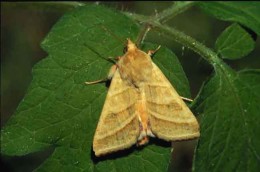
The wingspan is approximately 38.0 mm. Adult females can lay between 500 and 1,000 eggs within 2 to 3 days. Caterpillars are 38.0 mm in length when full-grown and vary in color depending on the host plants fed upon. The caterpillars (larvae) may be black, pale brown, yellow, green, and/or red. They may also possess stripes that extend the length of the body (Figure 2).
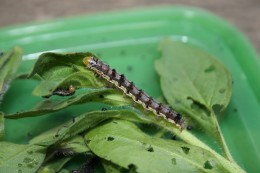
Furthermore, caterpillars may have small hairs or setae on localized sections of the body. The caterpillars tunnel into buds (Figure 3)
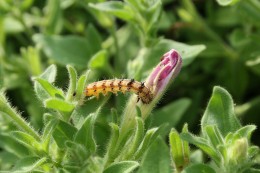
and feed from inside or chew flower petals, which appear ragged (Figure 4).
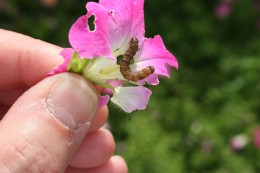
Damage usually increases during the growing season. Furthermore, caterpillars feeding inside flower buds on developing ovaries will destroy flowers. Be on the look-out for black fecal deposits (“caterpillar poop”) (Figure 5)

on the flower petals or on leaves below the flowers, which is a clear indication that the caterpillars are feeding. Tobacco budworm caterpillars will feed on a number of annual bedding plants besides geraniums and petunias, including: ageratum, chrysanthemum, nicotiana, snapdragon, and strawflower. Ivy geraniums may be less susceptible than other geranium types. The way to deal with tobacco budworm populations is to apply insecticides before the caterpillars tunnel into the buds using materials containing the following active ingredients: spinosad, cyfluthrin, permethrin, or bifenthrin. Be sure to thoroughly cover all plant parts as tobacco budworm caterpillars will also feed on plant leaves.
You can find more information on tobacco budworm feeding on petunia in the following article:
Davidson, N. A., M. G. Kinsey, L. E. Ehler, and G. W. Frankie. 1992. Tobacco budworm, pest of petunias, can be managed with Bt. California Agriculture 46 (July-August): 79.
By Dr. Raymond Cloyd
We have received inquiries regarding cucumber and squash plants wilting and collapsing, and a recent visit to the Manhattan Community Garden (Manhattan, KS) provided evidence that the larvae of the squash vine borer (Melittia cucurbitae) are indeed active inside plants. Squash vine borers feed on squash, pumpkin, cucumber, and muskmelon.
Adults are “clear wing” moths 5/8 inches long. The front wings are covered with scales whereas the hind wings are transparent because they do not have scales. Hind wings have red-brown hairs along the edges. The body is orange-red, with gray bands and three black markings along with orange-red hairs on the abdomen (Figure 1).
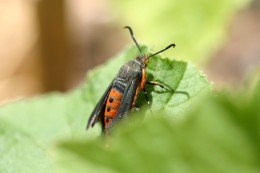
Moths are active during the day with females depositing eggs on the stem near the soil level or on stems or petioles when plants begin to flower. The eggs are red-brown, flattened, 1/30 inches in diameter, and are typically located at the base of plants (Figure 2).

A single female is capable of producing up to 200 eggs. Larvae that hatch from eggs are white, with a dark head capsule. Young larvae are 1/4 to 3/4 inches in length and taper toward the end of the abdomen (Figure 3).
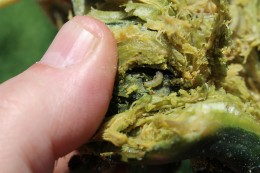
Mature or fully-grown larvae are 1.0 to 1.5 inches long (Figure 4).
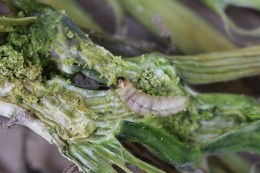
Larvae that hatch from eggs immediately tunnel into the base of plants. The larvae feed for 30 days in the plant stem, and increase in size as they mature. Typically there is only one larva per stem; however, multiple larvae may be present in a single tunnel in the stem. Mature larvae leave plants and burrow into the soil to pupate by constructing brown, silkened cocoons in which they overwinter. Squash vine borer overwinters as a mature larva in the cocoon that is located 1.0 to 2.0 inches in the soil. In early spring, the adult (moth) emerges from the soil. Squash vine borer has one generation in Kansas.
At this point, squash vine borer larvae are feeding within the internal vascular tissues inhibiting the plant’s ability to take-up water and nutrients; consequently, resulting in sudden wilting of vines and plant collapse (Figure 5).
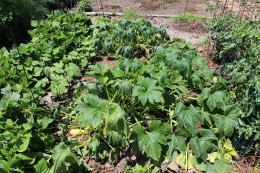
Once the larvae are inside the plant, there is little that can be done to control them or prevent damage. The tunnels inside infested plants are packed with moistened frass (fecal matter) (Figure 6).
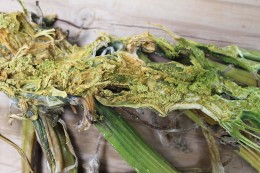
Yellow-green sawdust-like frass can also be found around feeding sites at the base of vines or plants (Figure 7)

,which will be a direct indication that larvae have entered the plant.
Since the larvae are feeding inside the plant there is not much that can be done to kill the larvae; however, there are number of plant protection strategies that can be implemented during the remainder of the growing season, including: sanitation and physical control.
Sanitation: remove and dispose of all wilted plants before the larvae leave and enter the soil. Discard all plant debris such as vines and fruits after harvest.
Physical control: rototilling in fall or spring will directly kill squash vine borer pupae or bring the pupae to the soil surface where they are exposed to cold weather or predation by birds. In addition, the process of deep plowing will bury the pupae deeper in the soil profile thus inhibiting adult emergence. Another technique that may have limited use in large plantings but may be feasible for smaller plantings is to locate infested stems and vines, create slits at the base of the plant, and then use tweezers to remove and destroy the larvae inside. The plant base should then be covered with moist soil, which stimulates the production of secondary vines and/or root growth; thus helping the plant to re-establish.
There is a new up-dated extension publication on squash vine borer (MF3309) that contains current information on plant protection with images of the insect (both adult and larva) and plant damage. You can download a PDF from the following website:
http://www.bookstore.ksre.ksu.edu/pubs/MF3309.pdf
— by Dr. Raymond Cloyd
Japanese beetle adults are out in full-force in certain regions of Kansas feeding on one of their favorite host plants…roses. The means of dealing with the adult stage of this insect pest are limited, however, and have been for many years, with the use of insecticides being the primary plant protection strategy. Japanese beetle, Popillia japonica is native to Japan and was first reported in the United States in 1916 in the state of New Jersey. Since then, Japanese beetles have spread throughout the country from Maine to Georgia with permanent establishments in nearly every state east of the Mississippi River and several western states west of the Mississippi River. Japanese beetles are established in eastern and central portions of Kansas and are slowly moving further west. The adult is one of the most destructive insect pests of horticultural plants in both landscapes and gardens. The larvae or grub is a major turfgrass pest in home lawns, commercial settings, and golf courses.
Japanese beetle adults are 9/16 inches long and metallic green with coppery-brown wing covers (Figure 1).
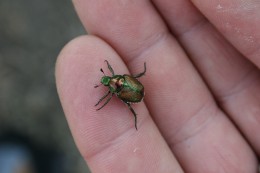
There are approximately 14 tufts of white hair present along the median of the abdomen (Figure 2).
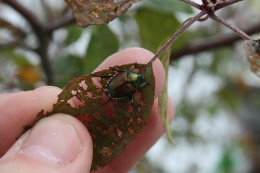
Adult Japanese beetles emerge from the soil and live from 30 to 45 days feeding on plants over a four-to-six-week period. They feed on many ornamental plants including trees, shrubs, vines, herbaceous annual and perennials, and of course—roses. Plant placement in the landscape and volatiles emitted by plants are factors that influence adult acceptance. Furthermore, Japanese beetle adults produce aggregation pheromones that attract individuals (both males and females) to the same feeding location. Adults may fly up to five miles to locate a feeding site; however, they tend to fly only short distances to feed and lay eggs.
Japanese beetle adults feed through the upper leaf surface (epidermis) and leaf center (mesophyll), leaving the lower epidermis intact. They usually avoid feeding on tissue between leaf veins, resulting in leaves appearing lace-like or skeletonized (Figure 3).
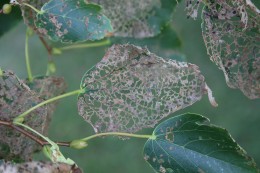
Adults are most active during warm days, feeding on plants that are exposed to sunlight throughout the day, which is likely why roses are a susceptible host plant because they require at least six hours of direct sunlight. Japanese beetle adults also start feeding at the top of plants, migrating downward after depleting food sources. Japanese beetle adults aggregate in masses on rose flowers (Figure 4).
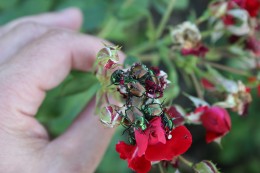
Although adult beetles feed primarily on flowers, they will also feed on leaves (Figure 5).

Japanese beetle adults chew holes in flower buds, which prevent flowers from opening or cause petals to fall prematurely. Moreover, adults will consume entire rose petals, and feed on the pollen of fully-opened flowers.
Japanese beetle adult management involves implementing a variety of plant protection strategies, including: cultural, physical, and insecticidal. Cultural involves maintaining healthy roses through proper irrigation, fertility, mulching, and pruning, which are important in minimizing any type of stress; thus possibly decreasing susceptibility. Also, removing weeds such as smartweed (Polygonum spp.) that are attractive to Japanese beetle adults will at least alleviate infestations. Physical is associated with hand-picking or collecting Japanese beetle adults from roses before populations are extensive. The appropriate time to hand-pick or collect adult beetles is in the morning when ambient air temperatures are typically “cooler.” Adults can be easily collected by placing a wide-mouthed jar or bucket containing rubbing alcohol (70% isopropyl alcohol) or soapy water underneath each adult, and then touching them. Adults that are disturbed fold their legs perpendicular to the body, and fall into the liquid and are subsequently killed. This procedure, when conducted daily or every-other-day, particularly after adults emerge, may substantially reduce plant damage. The use of Japanese beetle traps is not recommended since the floral lure and synthetically-derived sex pheromone may attract more adult beetles into an area than would “normally” occur. Adult beetles may also feed on roses before reaching the traps, which increases potential damage.
Spray applications of contact insecticides will kill Japanese beetle adults. Repeat applications will be required; especially when populations are excessive. Furthermore, thorough coverage of all plant parts will increase effectiveness of the application. The insecticide carbaryl (Sevin) and several pyrethroid-based insecticides including those containing bifenthrin or cyfluthrin as the active ingredient may be used to suppress Japanese beetle adult populations. However, since most of these insecticides are also directly harmful to many natural enemies (parasitoids and predators) their continual use may lead to secondary pest outbreaks of other pests including the twospotted spider mite (Tetranychus urticae). Moreover, these insecticides are directly harmful to pollinators (honey bees and bumble bees). Therefore, applications should be conducted in the early morning or late evening when pollinators are less active. In general, systemic insecticides, are not effective because Japanese beetle adults have to feed on leaves and consume lethal concentrations of the active ingredient. If extensive populations are present, then damage to plants may still occur.
The battle or war against Japanese beetle adults requires patience, persistence, and diligence in order to prevent adults from causing substantial damage to roses and other susceptible plants.
For more information on Japanese beetle and other pests of roses consult the following publication:
Compendium of Rose Diseases and Pests (second edition). 2007. APS Press. The American Phytopathological Society, St. Paul, MN.
— by Dr. Raymond Cloyd
Green June beetle (Cotinis nitida) adults are actively flying around and “bumping” into people and objects. Adults are 3/4 to 1.0 inches in length, and velvety-green, tinged with yellow-brown coloration (Figure 1).
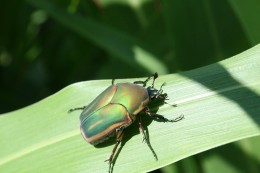
Green stripes with yellow-orange margins extend lengthwise on the front wings. The underside of the body is distinctly shiny and metallic green or gold. Adults fly like “dive bombers” over turfgrass for several weeks in mid-summer. The green June beetle has a one-year life cycle, and overwinters as a mature larva (grub). Adults emerge in late-June and are active during the day, resting at night on plants or in thatch. The adults produce a sound that resembles that of bumble bees. Adults will feed on ripening fruits (Figure 2) and may occasionally feed on plant leaves.
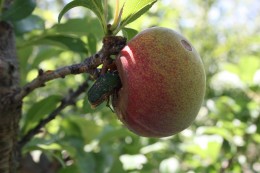
The male beetles swarm in the morning, “dive bombing” to-and-fro above the turfgrass searching for females that are located in the turfgrass (they are desperately seeking a mate. Females emit a pheromone that attracts males. Eventually, clusters of beetles will be present on the surface of the soil or turfgrass with several males attempting to mate with a single female (I think this qualifies as an “insect orgy.” Mated females that have survived the experience lay a cluster of 10 to 30 eggs into moist soil that contains an abundance of organic matter. Eggs hatch in about 2 weeks in early August and the young larvae feed near the soil surface. The larvae feed primarily on organic matter including thatch and grass-clippings; preferring soils that are excessive moist. Larvae are 3/8 (early instars) to 1.5 (later instars) inches in length, and exhibit a strange behavioral trait—they crawl on their back (Figure 3) because that they have a constant itch.
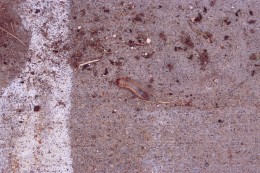
–Dr. Jeff Whitworth and Dr. Holly Schwarting
Ticks are very active throughout the state, and have been for the past month. The most commonly reported species has been the American dog tick, Dermacentor variabilis.
The cool, humid weather over the past month has provided great conditions for tick development. These annoying, and potentially dangerous parasites have even been encountered in corn fields, which is unusual as they typically develop in more undisturbed areas of grasses, weeds, and other overgrown vegetation. But, they are very good at finding hosts and getting the blood meal they require for development and reproduction. For more information on ticks in Kansas, please visit: https://www.vet.k-state.edu/vhc/docs/ticks-in-kansas.pdf
–Dr. Jeff Whitworth and Dr. Holly Schwarting
Termites and ants have both been swarming intermittently for the past couple of weeks. Both species usually start swarming in April in Kansas, but the cooler April temperatures seemed to have delayed this behavior for about a month.
Please make positive identification of any insects you suspect may be a pest, but especially ants and termites because there is an enormous difference in the amount of damage potential of termites vs. ants. Note that although carpenter ants may nest in wooden structures, they will not cause the same degree of damage as a termite infestation. Because of this, the cost of management for a termite infestation is much greater than carpenter ants. For more information on termites and ants, please visit:
Termites: https://www.bookstore.ksre.ksu.edu/pubs/MF2887.pdf
–Dr. Jeff Whitworth and Dr. Holly Schwarting
These large bumble bee look a-likes have been relatively active across the state in the last week. The reproductive adults, especially the’ bald-faced’ males are quite noticeable around wooden structures. These males are very territorial and their behavior of ‘dive-bombing’ any intruders, including humans and pets, is what draws attention to their presence. These males are totally harmless as they do not have the ability to sting, and will die shortly after mating with females that emerge in the area.
Carpenter bees do not consume wood but do tunnel into untreated wooden structures to create nests for oviposition and larval development. Please see the KSU, Carpenter Bees, for biology and management information:
–by Dr. Raymond Cloyd
The European fruit lecanium scale (Parthenolecanium cornii) is quite noticeable on bald cypress (Taxodium distichum) twigs and branches. The damage associated with this scale, which depends on the extensiveness of the infestation, includes plant stunting and wilting. The European fruit lecanium scale is a soft scale, so honeydew (a sticky, clear liquid) will be produced during feeding. The honeydew serves as a substrate for black sooty mold and attracts ants. In addition, honeydew can drip onto vehicles parked underneath infested trees leaving unsightly residue.
The scales are dark brown, 1/8 to 1/4 inches in diameter (Figures 1 and 2). Some scales may have white markings on the body. European fruit lecanium scale overwinters as an immature on twigs and branches with maturing occurring in spring. In May and June, females lay many eggs underneath their bodies. In June eggs hatch into small tan-colored crawlers. The duration of an egg hatch can last several days depending on the temperature. Crawlers migrate to leaf undersides and subsequently feed on plant fluids until late summer. At that point, the crawlers migrate back onto twigs and branches to complete their development the following spring. There is one generation per year in Kansas.
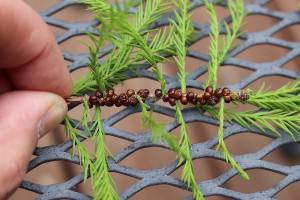

Figure 1 & 2: Mature European Fruit Lecanium Scale on Bald Cypress
Management of European fruit lecanium scale primarily involves timely applications of insecticides. Applications should be made when crawlers are present because the crawlers are most vulnerable life stage to insecticide sprays. Mature scales possess a shell-like covering that protects them from exposure to insecticides. Repeat applications will be required as the eggs do not all hatch simultaneously but may hatch over a three to four-week period. The most appropriate time to apply insecticides is in late June to early July when the crawlers are feeding on leaves; thus enhancing their exposure to any spray residues. There are a number of insecticides, with contact activity that are effective in suppressing populations of the European fruit lecanium scale. However, many have broad-spectrum activity and will kill many natural enemies including: parasitoids and predators. In fact, most out-breaks of scale insects are caused by the indiscriminate use of pesticides (insecticides and miticides). Therefore, always read the label and exercise caution when applying any pesticide. In the winter, dormant oils can be applied to kill overwintering scales by means of suffocation.
I need to acknowledge Jeff Otto of Wichita, KS for bringing to my attention that European fruit lecanium scale was active. I have also observed infestations in Manhattan, KS.
–by Dr. Raymond Cloyd
New Extension Publication on “Brownheaded Ash Sawfly” (MF-3297). The publication can be accessed from the following link:
http://www.bookstore.ksre.ksu.edu/Item.aspx?catId=524&pubId=19699